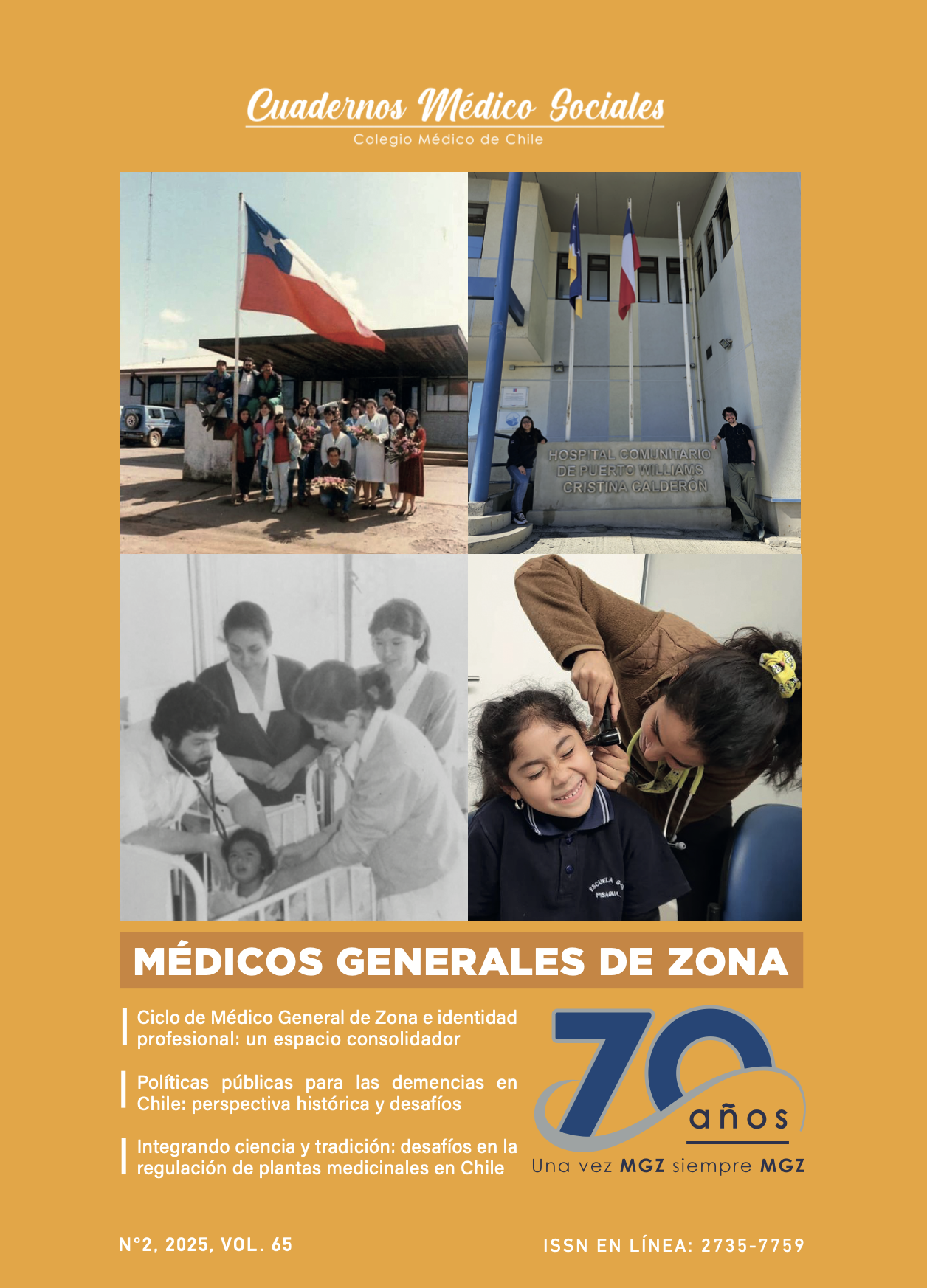The Ismael Valdés Valdés Comprehensive Care Center (1967 to 1973). A model of comprehensive maternal and child care in times of change
DOI:
https://doi.org/10.56116/cms.v65.n2.2025.2315Keywords:
Public Health, Comprehensive CareAbstract
The Ismael Valdés Valdés Comprehensive Maternal and Child Care Center operated between 1967 and 1973 and, like many other initiatives of the time, was forced to close due to direct repression or repression against its members during the dictatorship. This pioneering experience represented a model in social and community medicine, progressively built since the early years of the 20th century, and consolidated as a significant contribution to the country's public health, especially for the poorest population and for the training of professionals who practiced there.
Revisiting history, through written records and testimonies from participants, allows us to reconnect with its origins, understand the tradition represented, and explore the relevance and lessons for the present.
The article is organized into three parts. First, it analyzes the historical context of the second half of the last century and the development of Health Units, interpreting the Ismael Valdés Valdés Center as part of that evolution. It then describes the main characteristics and achievements, highlighting the comprehensive care model, community participation, teaching, research, multidisciplinary and intersectoral work, and, as a central achievement, the reduction of child malnutrition. Finally, the third part presents the conclusions, highlighting that the Center was the result of the convergence of the tradition of Health Units, the situation generated by the development of the National Health Service, and the drive of the team that carried out the experience of the Quinta Normal Comprehensive Medical Demonstration Center, from which it was spun off to respond to urgent maternal and child needs. Not only did it anticipate elements of the current comprehensive and community-based model, but it also validated it in practice, showing that it is possible to significantly improve health indicators and equity in innovative ways and in partnership with the community. This model remains a benchmark for addressing the current health challenges and needs of people and their communities.
Downloads
References
• Castañeda P., Salamé A. M. (2014). Trabajo Social chileno y dictadura militar. Memoria Profesional predictatorial período 1960-1973, Rumbos TS, 9 (9): 8 – 25.
• Gnecco, G. (s/f). Presentación con motivo del Homenaje al Dr. Benjamín Viel, Comunicación Personal.
• Godoy M., Ortiz Y., Falabella N. (1961). Desarrollo y perspectiva de la enfermería sanitaria en Chile. Boletín de la Oficina Sanitaria, 51 (2), Agosto.
• Horwitz, A. (1956). Medicina en Chile. Editorial, Revista del Servicio Nacional de Salud, 1(1): 3-4.
• Ipinza Riveros M. (1961). Benjamín Viel, 1984, Discurso de Incorporación a la Academia de Medicina, del Instituto de Chile, citado por Gilda Gnecco.
• Ipinza, Riveros M. (1966). Censo de Población y de Vivienda para la Organización de un Centro de Atención Materno Infantil, Tesis para optar al Grado de Profesor Auxiliar de Medicina Preventiva y Social, Facultad de Medicina, Universidad de Chile. Ipinza Riveros, M. . (2007). Calidad y Atención Integral de Salud: dos conceptos inseparables. Cuadernos Médico Sociales, 47(1), 5–17. Recuperado a partir de https://cuadernosms.cl/index.php/cms/article/view/661
• Kirkwood, J. (1990). Ser política en Chile. Los nudos de la sabiduría feminista. Editorial Cuarto Propio.
• Molina, G. (1952). Relato Unidad Sanitaria Quinta Normal, Actas de la Primera Jornada de la Sociedad Chilena de Salubridad, 20 – 21.
• Molina, G. (1971). El gobierno de Allende y los médicos, Vida Médica 22 (?): 12-14.
• Molina, R., López, J., Orellana, M. ., Orlandi, E. ., & Alarcón, J. . (1978). Características del Aborto en Chile . Cuadernos Médico Sociales, 19(1), 5–18. Recuperado a partir de https://cuadernosms.cl/index.php/cms/article/view/1711
• Molina-Guzman G. (1979). Third World Experiences in Health Planning. International Journal of Health Services. 9(1):139-150. doi:10.2190/KM06-JY3Y-KACE-008X
• Mönckeberg B, Fernando. (2014). Prevención del daño: impacto económico y social. Revista chilena de nutrición, 41(2), 181-190. https://dx.doi.org/10.4067/S0717-75182014000200009
• Montoya, C. . (1961). Una experiencia en medicina integral: Informe preliminar. Cuadernos Médico Sociales, 2(2), 10–13. Recuperado a partir de https://www.cuadernosms.cl/index.php/cms/article/view/2299
• Montoya C., Medina E., Toro J. (2007). Sinopsis sanitaria chilena, Anales chilenos de historia de la Medicina, 17: 77- 93
• Oses, D. (1990). Doctor Benjamín Viel Vicuña. Revista Vida Médica, 42 (3): 164-166.
• Ramacciotti K. (2017). La Fundación Rockefeller y la división internacional de salud en el Río de la Plata y la región andina. Ideas, concreciones y obstáculos (1941-1949), Redes, 23 (45): 97-121.
• Romero O., Nacianceno (1952). Unidades Sanitarias en Chile, Boletín de la Oficina Panamericana de Salud, 33 (1): 11 – 17 (11)
• Salomón Rex, C. (1946). Organización y funcionamiento de una unidad sanitaria [Tesis de grado, Universidad de Chile]. Imprenta Universitaria.
• Sepúlveda L. (2020), Trabajando lo Social, una trayectoria de compromiso, Ediciones Universidad Academia de Humanismo Cristiano.
• Subsecretaría de Redes Asistenciales, Ministerio de Salud (2025). Orientaciones para la Planificación y Programación en Red.
• Torres, Isabel (1990). “La década de los sesenta en Chile: La utopía como proyecto”, Historia Actual on Line (HAOL), 19: 139-149.
• Viel, B. (1961). La medicina socializada: y su aplicación en Gran Bretaña, Unión Soviética y Chile, Ediciones Universidad de Chile.
• Viel , B. y cols. (1968). Resultados de los primeros 7 meses de funcionamiento del “Centro de Atención Pediátrica Integral, Ismael Valdés Valdés”, Apartado de la Revista Chilena de Pediatría, 29 (4).
• Waitzkin, H., Iriart, C., Estrada, ., & Lamadrid, S. (2001). Social medicine then and now: lessons from Latin America. American journal of public health, 91(10), 1592–1601. https://doi.org/10.2105/ajph.91.10.1592
• Zárate M. S. , González, M. (2019). Trabajo, miserias y recompensas. Asistentes sociales, enfermeras y matronas en la construcción de la política sanitaria chilena a mediados del siglo XX. Revista Salud Colectiva, 15 (-), 1-14.
Downloads
Published
How to Cite
Issue
Section
Categories
License
Copyright (c) 2025 Jorge Lastra Torres, Jossette Iribarne – Wiff

This work is licensed under a Creative Commons Attribution-NonCommercial-ShareAlike 4.0 International License.


